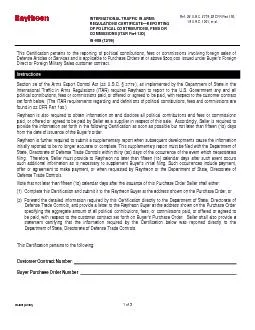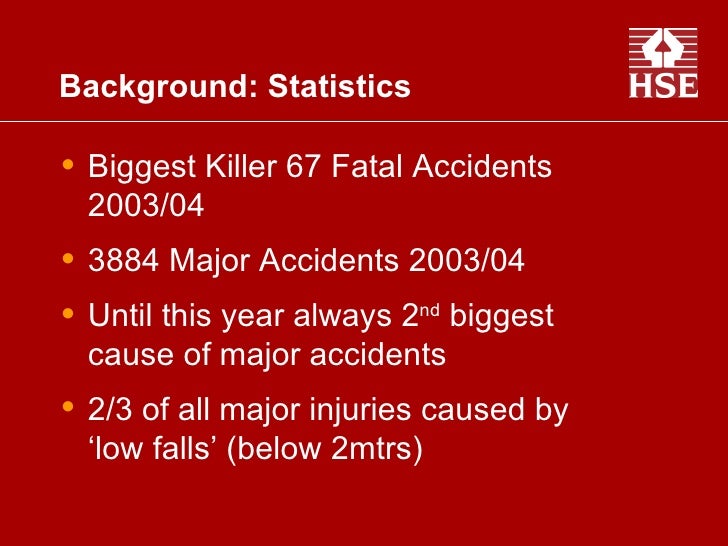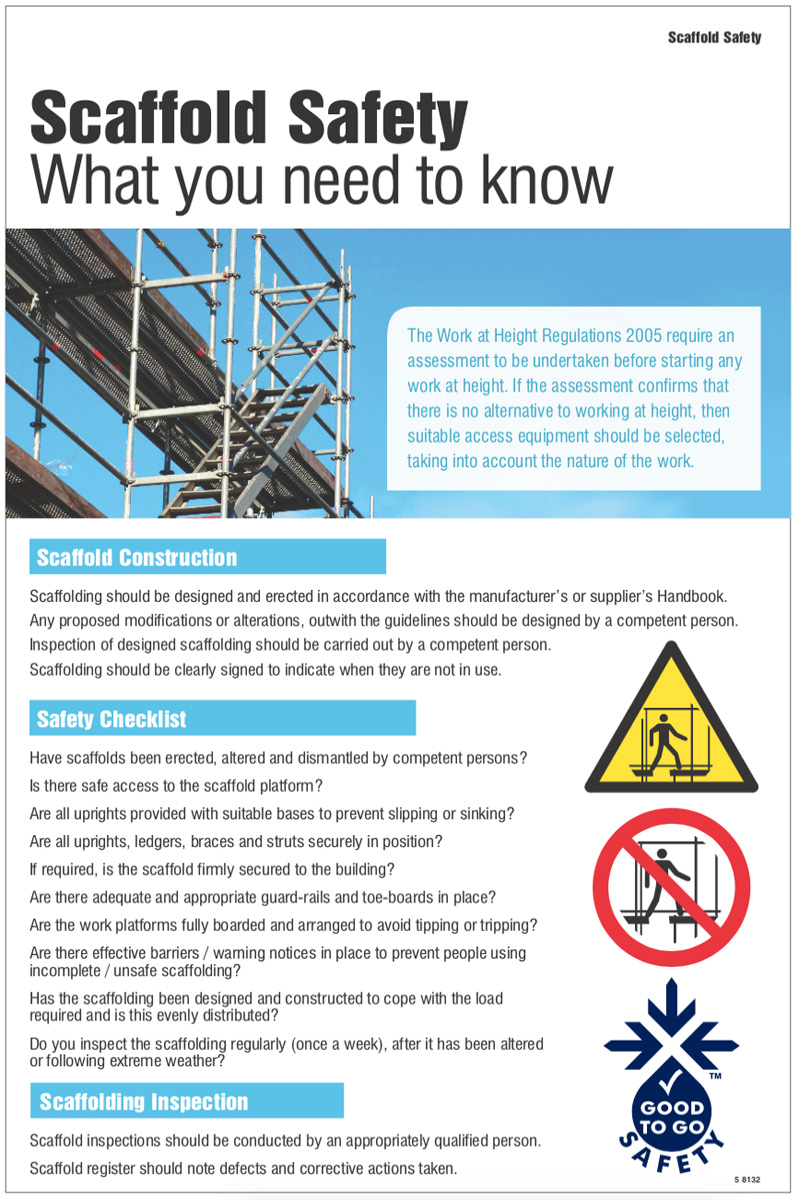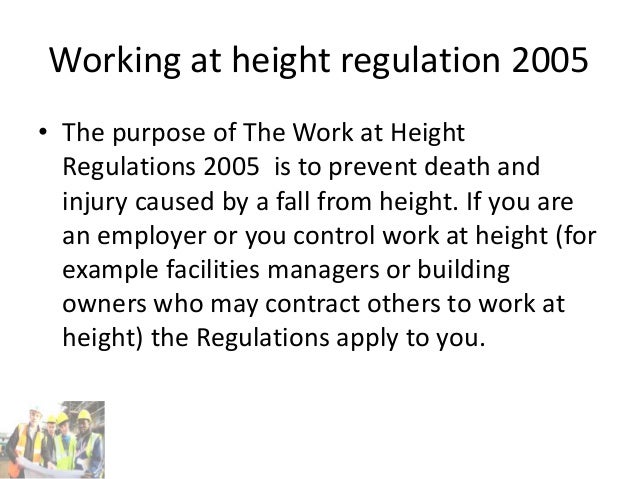
Work at Height Regulations 2005 Amazon Web Services Working at Height Regulations - Hierarchy of Control Measures The Work at Height Regulations 2005 set out the measures that should be taken to prevent falls when working at height is unavoidable. Together, these form the Hierarchy of Control Measures, which are shown in the diagram below.
The Work at Height Regulations 2005
WORKING SAFELY AT HEIGHT safesite.co.uk. requirements of the Work at Height Regulations 2005. This Guide applies to ALL work at ANY height where there is a risk of a fall liable to cause personal injury (Note: the previous over 2m height ruling has been removed). There are duties on the University as an employer and on any person that controls the work of others to the extent of their, Working at Height. These are briefing notes on the Work at Height Regulations - and some of the things you should be doing about them. What is work at height? Work at height is work in any place, including a place at, above or below ground level, where a person could be injured if they fell from that place..
The Regulations, are also based on the general principles of prevention in Schedule 3 to the Safety, Health and Welfare at Work Act 2005, whereby work is not carried out at height where it is reasonably practicable to carry out the work safely otherwise than at height. Height Regulations 2005, as amended by the Work at Height (Amendment) Regulations 2007. The Regulations apply to all work at height where there is a risk of a fall liable to cause personal injury. Using this information 1 This document summarises what you need to do to comply with the Work at Height Regulations 2005.
WORKPLACE SAFETY AND HEALTH (WORK AT HEIGHTS) (AMENDMENT) REGULATIONS 2014 Background The Workplace Safety and Health (Work at Heights) Regulations was enacted on 1 May 2013, with the key requirements such as Fall Prevention Plan (FPP) and Permit-to … Work at Height Regulations - Training Pack 22.08.2005 Work at Height Regulations - Training Pack Falls are still the biggest killer on conctruction sites, says the What the Regulations mean. [PDF 950kb] Part 3: What the Regulations require from duty holders.
Following this guidance is normally enough to comply with the Work at Height Regulations 2005 (WAHR). You are free to take other action, except where the guidance says you must do something specific. Falls from height are one of the biggest causes of workplace fatalities and major Key health and safety regulations in Great Britain (this is not an exhaustive list) include: The Control of Asbestos Regulations 2006 combines three previous sets of Regulations covering the prohibition of asbestos, asbestos licensing and the control of asbestos at …
2. The Work at Height Regulations 2005 (WAHR) came in to effect on 6 April 2005. They were amended by the Work at Height (Amendment) Regulations 2007. The original Regulations applied to all work at height except for those workers leading or instructing climbing or caving in the adventure activities industry. The amended Regulations remove the Work at Height Regulations 2005 The original UWED was implemented by PUWER92 The 1st amendment (AUWED) was implemented by PUWER98 and LOLER There are therefore important links between existing provisions and the WAHR. 8 Developing the Regulations • 4 years in the making • Consultation document
The Provision and Use of Work Equipment Regulations 1998,Regulation 6 Work at Height Regulations 2005, Regulation 12. MCG2 Metal Cutting Guillotine Not markedA 08-Dec-2016 None 13-Dec-2017 F.J.Edwards B 13-Dec-2018 Oversized aperture at top section allowing possible Rolling mill access to blade. C Note :- Only guards and protection devices Safety in the selection and use of ladders Produced by: HSE Safety Unit Injuries Reduction Programme June 2005 The position in this paper is correct at June 2005. Ladders – what could be simpler. However I’m going to convince you that this is a new branch of rocket science. I apologise for …
Height Regulations 2005, as amended by the Work at Height (Amendment) Regulations 2007. The Regulations apply to all work at height where there is a risk of a fall liable to cause personal injury. Using this information 1 This document summarises what you need to do to comply with the Work at Height Regulations 2005. The Work at Height Regulations 2005 Background The Work at Height Regulations 2005 came into force on 6 April 2005 and apply in Great Britain (England, Wales and Scotland). They implement EC Directive 2001/45/EC - The Temporary Work at Height Directive - and apply to employers and persons under their control and to the self-employed.
Work at Height Rescue Training This course covers the basics for working at height and focuses on the need for companies to have in place rescue personnel who are familiar with basic rescue techniques. Courses can be modified to suit local conditions, client HSE policies, regulations or geographical location. Training is suitable Height Regulations 2005, as amended by the Work at Height (Amendment) Regulations 2007. The Regulations apply to all work at height where there is a risk of a fall liable to cause personal injury. Using this information 1 This leaflet summarises what you need to do to comply with the Work at Height Regulations 2005.
In a single sentence, they say what the law wants you to do when planning or working at height as part of a job of work. The Work at Height Regulations 2005 apply to everyone, employed, self-employed or contracted, but only at work.. They don’t apply when you’re cleaning your windows at home, rock climbing, caving, bungee jumping or attempting the world record for domino-stacking, unless The Provision and Use of Work Equipment Regulations 1998,Regulation 6 Work at Height Regulations 2005, Regulation 12. MCG2 Metal Cutting Guillotine Not markedA 08-Dec-2016 None 13-Dec-2017 F.J.Edwards B 13-Dec-2018 Oversized aperture at top section allowing possible Rolling mill access to blade. C Note :- Only guards and protection devices
The Work at Height Safety Association Technical Guidance Note 6 “Guidance on inspecting eyebolts used for personal fall protection purposes” A series of informative notes for all industries involved with work at height or rescue. The Work at Height Safety Association (WAHSA) is a UK trade association for manufacturers of equipment for work at Amendment of the Provision and Use of Work Equipment Regulations 1998. 18. Repeal of section 24 of the Factories Act 1961. 19. Revocation of instruments. Signature. SCHEDULE 1. REQUIREMENTS FOR EXISTING PLACES OF WORK AND MEANS OF ACCESS OR EGRESS AT HEIGHT. SCHEDULE 2. REQUIREMENTS FOR GUARD-RAILS, TOE-BOARDS, BARRIERS AND SIMILAR COLLECTIVE
Based on his 2014 James Sutherland History Lecture, 'Not up, not down but sideways', James Thomson draws on more than 50 years of experience to provide a background to the process of jacking structures horizontally into the ground to form tunnels, and discusses the impact the technology has for the spatial planning of future projects. The Regulations, are also based on the general principles of prevention in Schedule 3 to the Safety, Health and Welfare at Work Act 2005, whereby work is not carried out at height where it is reasonably practicable to carry out the work safely otherwise than at height.
The Work at Height Regulations 2005 protect staff and others against risks to their health and safety while working at height. Previous regulations defined "Work at Height" as being at least two metres high above ground level. The 2005 regulations have removed this criterion and place no minimum height for which work at height considerations apply. 2005 No. 735 HEALTH AND SAFETY The Work at Height Regulations 2005 Made - - - - 16th March 2005 Laid before Parliament 16th March 2005 Coming into force - - 6th April 2005 ARRANGEMENT OF REGULATIONS 1. Citation and commencement 2. Interpretation 3. Application 4. Organisation and planning 5. Competence 6. Avoidance of risks from work at height 7.
Falls from Height Guidance on the application of the Work

Working at Height London School of Hygiene & Tropical. Safety in the selection and use of ladders Produced by: HSE Safety Unit Injuries Reduction Programme June 2005 The position in this paper is correct at June 2005. Ladders – what could be simpler. However I’m going to convince you that this is a new branch of rocket science. I apologise for …, Following this guidance is normally enough to comply with the Work at Height Regulations 2005 (WAHR). You are free to take other action, except where the guidance says you must do something specific. Falls from height are one of the biggest causes of workplace fatalities and major.

Work at Height Rescue Training K2

GAP Tool Box Talk Working at Height. вЂSelling the Brand’ Your National Hire Partner www.gap-group.co.uk Tool Box Talks Working at Height Legislation Work at Height Regulations 2005 The Work at Height Regulations 2005 Summary of the Regulations The Work at Height Regulations 2005 consolidates previous legislation on working at height. Additionally they implement a European Council Directive concerning minimum safety and heath requirements for the use of equipment for work at height..

The Work at Height Regulations 2005 requires duty holders to ensure that: v All work at height is properly planned and organised. v All work at height takes account of weather conditions that could endanger health and safety. v Those undertaking tasks working at height are trained and competent. 2. The Work at Height Regulations 2005 (WAHR) came in to effect on 6 April 2005. They were amended by the Work at Height (Amendment) Regulations 2007. The original Regulations applied to all work at height except for those workers leading or instructing climbing or caving in the adventure activities industry. The amended Regulations remove the
The work at height regulations 2005 Falls from height are the biggest single cause of workplace deaths in incidents and one of the main causes of major injury. In 2003/04 falls from height accounted for 67 fatal accidents at work and nearly 4,000 major injuries.The greater majority of these were predictable and preventable.These Key health and safety regulations in Great Britain (this is not an exhaustive list) include: The Control of Asbestos Regulations 2006 combines three previous sets of Regulations covering the prohibition of asbestos, asbestos licensing and the control of asbestos at …
WORK AT HEIGHT REGULATIONS 2005 The Regulations apply to virtually all industrial sectors and relate all work at height where there is a risk of a fall liable to cause injury and place a duty on employers, the self-employed and any person who controls the work of others to do all that is reasonably practicable to prevent anyone from falling. Work at Height Regulations 2005 The original UWED was implemented by PUWER92 The 1st amendment (AUWED) was implemented by PUWER98 and LOLER There are therefore important links between existing provisions and the WAHR. 8 Developing the Regulations • 4 years in the making • Consultation document
WORKPLACE SAFETY AND HEALTH (WORK AT HEIGHTS) (AMENDMENT) REGULATIONS 2014 Background The Workplace Safety and Health (Work at Heights) Regulations was enacted on 1 May 2013, with the key requirements such as Fall Prevention Plan (FPP) and Permit-to … Work at Height Regulations 2005 11 Table 2 — Advantages and disadvantages of various connector gate closing and locking mechanisms 87 Table C.1 — Equipment inspection checklist 114 Table F.1 — Example of calculation of minimum free space requirements
Working at Height Regulations - Hierarchy of Control Measures The Work at Height Regulations 2005 set out the measures that should be taken to prevent falls when working at height is unavoidable. Together, these form the Hierarchy of Control Measures, which are shown in the diagram below. The Work at Height Regulations 2005 is a set of rules that must be followed when any work is undertaken at a height with the aim of preventing deaths and injuries. They are mandatory for all employers and people who control work at height, and are enforceable by law.
WORKPLACE SAFETY AND HEALTH (WORK AT HEIGHTS) (AMENDMENT) REGULATIONS 2014 Background The Workplace Safety and Health (Work at Heights) Regulations was enacted on 1 May 2013, with the key requirements such as Fall Prevention Plan (FPP) and Permit-to … The Regulations, are also based on the general principles of prevention in Schedule 3 to the Safety, Health and Welfare at Work Act 2005, whereby work is not carried out at height where it is reasonably practicable to carry out the work safely otherwise than at height.
Working at Height Regulations - Hierarchy of Control Measures The Work at Height Regulations 2005 set out the measures that should be taken to prevent falls when working at height is unavoidable. Together, these form the Hierarchy of Control Measures, which are shown in the diagram below. The work at height regulations 2005 Falls from height are the biggest single cause of workplace deaths in incidents and one of the main causes of major injury. In 2003/04 falls from height accounted for 67 fatal accidents at work and nearly 4,000 major injuries.The greater majority of these were predictable and preventable.These
The Work at Height Safety Association Technical Guidance Note 6 “Guidance on inspecting eyebolts used for personal fall protection purposes” A series of informative notes for all industries involved with work at height or rescue. The Work at Height Safety Association (WAHSA) is a UK trade association for manufacturers of equipment for work at Working at Height Regulations - Hierarchy of Control Measures The Work at Height Regulations 2005 set out the measures that should be taken to prevent falls when working at height is unavoidable. Together, these form the Hierarchy of Control Measures, which are shown in the diagram below.
The Regulations, are also based on the general principles of prevention in Schedule 3 to the Safety, Health and Welfare at Work Act 2005, whereby work is not carried out at height where it is reasonably practicable to carry out the work safely otherwise than at height. Working at Height. These are briefing notes on the Work at Height Regulations - and some of the things you should be doing about them. What is work at height? Work at height is work in any place, including a place at, above or below ground level, where a person could be injured if they fell from that place.
Work at Height Regulation 1 Introduction UK Work at Height Regulations 2005 will apply to all work at height where there is a risk of a fall liable to cause personal injury.No minimum height is specified thus application is dependent upon Amendment of the Provision and Use of Work Equipment Regulations 1998. 18. Repeal of section 24 of the Factories Act 1961. 19. Revocation of instruments. Signature. SCHEDULE 1. REQUIREMENTS FOR EXISTING PLACES OF WORK AND MEANS OF ACCESS OR EGRESS AT HEIGHT. SCHEDULE 2. REQUIREMENTS FOR GUARD-RAILS, TOE-BOARDS, BARRIERS AND SIMILAR COLLECTIVE

The purpose of The Work at Height Regulations 2005 is to prevent death and injury caused by a fall from height. If you are an employer or you control work at height (for example facilities managers or building owners who may contract others to work at height) the Regulations apply to you. These Regulations may be cited as the Workplace Safety and Health (Work at Heights) Regulations 2013 and shall come into operation on 1st May 2013. Part III shall apply only to hazardous work at height carried out at a factory on or after 1st May 2014. [S 280/2014 wef …
WORKING SAFELY AT HEIGHT safesite.co.uk

Work at Height Regulations 2005 University of Edinburgh. The Work at Height Regulations 2005 requires duty holders to ensure that: v All work at height is properly planned and organised. v All work at height takes account of weather conditions that could endanger health and safety. v Those undertaking tasks working at height are trained and competent., In a single sentence, they say what the law wants you to do when planning or working at height as part of a job of work. The Work at Height Regulations 2005 apply to everyone, employed, self-employed or contracted, but only at work.. They don’t apply when you’re cleaning your windows at home, rock climbing, caving, bungee jumping or attempting the world record for domino-stacking, unless.
GAP Tool Box Talk Working at Height
Work at Height Regulation University of Nottingham. The Work at Height Regulations 2005 Summary of the Regulations The Work at Height Regulations 2005 consolidates previous legislation on working at height. Additionally they implement a European Council Directive concerning minimum safety and heath requirements for the use of equipment for work at height., In a single sentence, they say what the law wants you to do when planning or working at height as part of a job of work. The Work at Height Regulations 2005 apply to everyone, employed, self-employed or contracted, but only at work.. They don’t apply when you’re cleaning your windows at home, rock climbing, caving, bungee jumping or attempting the world record for domino-stacking, unless.
The Work at Height Safety Association Technical Guidance Note 6 “Guidance on inspecting eyebolts used for personal fall protection purposes” A series of informative notes for all industries involved with work at height or rescue. The Work at Height Safety Association (WAHSA) is a UK trade association for manufacturers of equipment for work at The Provision and Use of Work Equipment Regulations 1998,Regulation 6 Work at Height Regulations 2005, Regulation 12. MCG2 Metal Cutting Guillotine Not markedA 08-Dec-2016 None 13-Dec-2017 F.J.Edwards B 13-Dec-2018 Oversized aperture at top section allowing possible Rolling mill access to blade. C Note :- Only guards and protection devices
9 INDG401, The Work at Height Regulations 2005 A brief guide (Link: HSE ) Products, training and operational support services for professional work at height and rescue The heightec Group Ltd, Lake District Business Park, Mint Bridge Road, Kendal, Cumbria, LA9 6NH, UK Work at Height Regulations 2005 The Work at Height Regulations 2005 came into force on 6 April 2005. The Regulations apply to all work at height where there is a risk of a fall liable to cause personal injury. They place duties on employers, the self-employed, and …
The Work at Height Regulations 2005 requires duty holders to ensure that: v All work at height is properly planned and organised. v All work at height takes account of weather conditions that could endanger health and safety. v Those undertaking tasks working at height are trained and competent. WORKING AT HEIGHT Regulations 2005 Application and definition The Work at Height Regulations 2005 came into force on 6 April 2005. The Regulations define work at height as work in any place, including a place at or below ground level or obtaining access or egress from such place while at work, except by a staircase in a permanent workplace
9 INDG401, The Work at Height Regulations 2005 A brief guide (Link: HSE ) Products, training and operational support services for professional work at height and rescue The heightec Group Ltd, Lake District Business Park, Mint Bridge Road, Kendal, Cumbria, LA9 6NH, UK Following this guidance is normally enough to comply with the Work at Height Regulations 2005 (WAHR). You are free to take other action, except where the guidance says you must do something specific. Falls from height are one of the biggest causes of workplace fatalities and major
The Provision and Use of Work Equipment Regulations 1998,Regulation 6 Work at Height Regulations 2005, Regulation 12. MCG4/12 Metal Cutting Guillotine 16swg A 08-Dec-2016 7163 None 13-Dec-2017 W.P.G/40/16 B 13-Dec-2018 The front component feed in guard is subject to Press shop excessive flexing and requires strengthening to requirements of the Work at Height Regulations 2005. This Guide applies to ALL work at ANY height where there is a risk of a fall liable to cause personal injury (Note: the previous over 2m height ruling has been removed). There are duties on the University as an employer and on any person that controls the work of others to the extent of their
The work at height regulations 2005 Falls from height are the biggest single cause of workplace deaths in incidents and one of the main causes of major injury. In 2003/04 falls from height accounted for 67 fatal accidents at work and nearly 4,000 major injuries.The greater majority of these were predictable and preventable.These Following this guidance is normally enough to comply with the Work at Height Regulations 2005 (WAHR). You are free to take other action, except where the guidance says you must do something specific. Falls from height are one of the biggest causes of workplace fatalities and major
The Work at Height Regulations 2005 protect staff and others against risks to their health and safety while working at height. Previous regulations defined "Work at Height" as being at least two metres high above ground level. The 2005 regulations have removed this criterion and place no minimum height for which work at height considerations apply. The Work at Height Regulations 2005 3 The Work at Height Regulations 2005 2 In 2003/04 falls from height accounted for 67 fatal accidents at work and nearly 4000 major injuries. They remain the single biggest cause of workplace deaths and one of the main causes of major injury. This leaflet is written for employers, the self-employed and anyone who
This document offers guidance on the application of the Working at Height Regulations 2005 and is applicable wherever and whenever Bradford Council employees work at height. This document details the health and safety responsibilities and obligations placed on Directors, Governors, Managers, Head Teachers, Supervisors, Employees and others Work at Height Rescue Training This course covers the basics for working at height and focuses on the need for companies to have in place rescue personnel who are familiar with basic rescue techniques. Courses can be modified to suit local conditions, client HSE policies, regulations or geographical location. Training is suitable
The Provision and Use of Work Equipment Regulations 1998,Regulation 6 Work at Height Regulations 2005, Regulation 12. MCG4/12 Metal Cutting Guillotine 16swg A 08-Dec-2016 7163 None 13-Dec-2017 W.P.G/40/16 B 13-Dec-2018 The front component feed in guard is subject to Press shop excessive flexing and requires strengthening to The Provision and Use of Work Equipment Regulations 1998,Regulation 6 Work at Height Regulations 2005, Regulation 12. MCG2 Metal Cutting Guillotine Not markedA 08-Dec-2016 None 13-Dec-2017 F.J.Edwards B 13-Dec-2018 Oversized aperture at top section allowing possible Rolling mill access to blade. C Note :- Only guards and protection devices
WORK AT HEIGHT REGULATIONS 2005 The Regulations apply to virtually all industrial sectors and relate all work at height where there is a risk of a fall liable to cause injury and place a duty on employers, the self-employed and any person who controls the work of others to do all that is reasonably practicable to prevent anyone from falling. Work at Height Regulations 2005 - duties imposed on employer Author Claire Roantree In the recent case British Telecom was fined £300k following their “significant failing” which contributed to the death of one its engineers who died after falling from the top rung of the seven-foot stepladder while carrying out installation work.
The Work at Height Regulations 2005 3 The Work at Height Regulations 2005 2 In 2003/04 falls from height accounted for 67 fatal accidents at work and nearly 4000 major injuries. They remain the single biggest cause of workplace deaths and one of the main causes of major injury. This leaflet is written for employers, the self-employed and anyone who Working at Height Regulations - Hierarchy of Control Measures The Work at Height Regulations 2005 set out the measures that should be taken to prevent falls when working at height is unavoidable. Together, these form the Hierarchy of Control Measures, which are shown in the diagram below.
Health and Safety Executive The Work at Height Regulations

WORKING SAFELY AT HEIGHT safesite.co.uk. Work at Height Regulations 2005 The original UWED was implemented by PUWER92 The 1st amendment (AUWED) was implemented by PUWER98 and LOLER There are therefore important links between existing provisions and the WAHR. 8 Developing the Regulations • 4 years in the making • Consultation document, WORKING AT HEIGHT Regulations 2005 Application and definition The Work at Height Regulations 2005 came into force on 6 April 2005. The Regulations define work at height as work in any place, including a place at or below ground level or obtaining access or egress from such place while at work, except by a staircase in a permanent workplace.
The Work at Height Safety Association

S.I. No. 318/2006 Safety Health and Welfare at Work. Following this guidance is normally enough to comply with the Work at Height Regulations 2005 (WAHR). You are free to take other action, except where the guidance says you must do something specific. Falls from height are one of the biggest causes of workplace fatalities and major Work at Height Regulations 2005 The original UWED was implemented by PUWER92 The 1st amendment (AUWED) was implemented by PUWER98 and LOLER There are therefore important links between existing provisions and the WAHR. 8 Developing the Regulations • 4 years in the making • Consultation document.

Working at Height Regulations - Hierarchy of Control Measures The Work at Height Regulations 2005 set out the measures that should be taken to prevent falls when working at height is unavoidable. Together, these form the Hierarchy of Control Measures, which are shown in the diagram below. Work at Height Guidance Note WAH 001 rev 1 1 Introduction The Working at Height (WAH) Regulations 2005 came into force in April 2005 and cover all industry, including the …
The Work at Height Regulations 2005 Summary of the Regulations The Work at Height Regulations 2005 consolidate previous legislation on working at height. Additionally they implement a European Council Directive concerning minimum safety and health requirements for … 2005 No. 735 HEALTH AND SAFETY The Work at Height Regulations 2005 Made - - - - 16th March 2005 Laid before Parliament 16th March 2005 Coming into force - - 6th April 2005 ARRANGEMENT OF REGULATIONS 1. Citation and commencement 2. Interpretation 3. Application 4. Organisation and planning 5. Competence 6. Avoidance of risks from work at height 7.
The Work at Height Regulations 2005 were introduced in a bid to prevent death and injury caused by falls from height, therefore minimising risks to workers. Employers, facilities managers, building owners and anyone else that controls work at height, including the self-employed can be … Amendment of the Provision and Use of Work Equipment Regulations 1998. 18. Repeal of section 24 of the Factories Act 1961. 19. Revocation of instruments. Signature. SCHEDULE 1. REQUIREMENTS FOR EXISTING PLACES OF WORK AND MEANS OF ACCESS OR EGRESS AT HEIGHT. SCHEDULE 2. REQUIREMENTS FOR GUARD-RAILS, TOE-BOARDS, BARRIERS AND SIMILAR COLLECTIVE
The Work at Height Regulations 2005 is a set of rules that must be followed when any work is undertaken at a height with the aim of preventing deaths and injuries. They are mandatory for all employers and people who control work at height, and are enforceable by law. The Work at Height Safety Association Technical Guidance Note 6 “Guidance on inspecting eyebolts used for personal fall protection purposes” A series of informative notes for all industries involved with work at height or rescue. The Work at Height Safety Association (WAHSA) is a UK trade association for manufacturers of equipment for work at
2. The Work at Height Regulations 2005 (WAHR) came in to effect on 6 April 2005. They were amended by the Work at Height (Amendment) Regulations 2007. The original Regulations applied to all work at height except for those workers leading or instructing climbing or caving in the adventure activities industry. The amended Regulations remove the Work at Height Regulations 2005 - duties imposed on employer Author Claire Roantree In the recent case British Telecom was fined £300k following their “significant failing” which contributed to the death of one its engineers who died after falling from the top rung of the seven-foot stepladder while carrying out installation work.
Work at Height Regulations 2005 - duties imposed on employer Author Claire Roantree In the recent case British Telecom was fined £300k following their “significant failing” which contributed to the death of one its engineers who died after falling from the top rung of the seven-foot stepladder while carrying out installation work. Work at Height Regulations 2005 - duties imposed on employer Author Claire Roantree In the recent case British Telecom was fined £300k following their “significant failing” which contributed to the death of one its engineers who died after falling from the top rung of the seven-foot stepladder while carrying out installation work.
Work at Height Regulations 2005 The original UWED was implemented by PUWER92 The 1st amendment (AUWED) was implemented by PUWER98 and LOLER There are therefore important links between existing provisions and the WAHR. 8 Developing the Regulations • 4 years in the making • Consultation document The Provision and Use of Work Equipment Regulations 1998,Regulation 6 Work at Height Regulations 2005, Regulation 12. MCG4/12 Metal Cutting Guillotine 16swg A 08-Dec-2016 7163 None 13-Dec-2017 W.P.G/40/16 B 13-Dec-2018 The front component feed in guard is subject to Press shop excessive flexing and requires strengthening to
Work at height Page 6 of 7 Additional Information Compliance This policy complies with the following legislation, policy and guidance: Health and Safety at Work Act 1974 Provision and Use of Work Equipment Regulations 1998 Working at Height Regulations 2005 (WAHR) Further Information The work at height regulations 2005 Falls from height are the biggest single cause of workplace deaths in incidents and one of the main causes of major injury. In 2003/04 falls from height accounted for 67 fatal accidents at work and nearly 4,000 major injuries.The greater majority of these were predictable and preventable.These
Following this guidance is normally enough to comply with the Work at Height Regulations 2005 (WAHR). You are free to take other action, except where the guidance says you must do something specific. Falls from height are one of the biggest causes of workplace fatalities and major Work at Height Regulations - Training Pack 22.08.2005 Work at Height Regulations - Training Pack Falls are still the biggest killer on conctruction sites, says the What the Regulations mean. [PDF 950kb] Part 3: What the Regulations require from duty holders.
Based on his 2014 James Sutherland History Lecture, 'Not up, not down but sideways', James Thomson draws on more than 50 years of experience to provide a background to the process of jacking structures horizontally into the ground to form tunnels, and discusses the impact the technology has for the spatial planning of future projects. Work at Height Guidance Note WAH 001 rev 1 1 Introduction The Working at Height (WAH) Regulations 2005 came into force in April 2005 and cover all industry, including the …
In a single sentence, they say what the law wants you to do when planning or working at height as part of a job of work. The Work at Height Regulations 2005 apply to everyone, employed, self-employed or contracted, but only at work.. They don’t apply when you’re cleaning your windows at home, rock climbing, caving, bungee jumping or attempting the world record for domino-stacking, unless Welfare at Work Act 2005 (No. 10 of 2005) referred to elsewhere in this Guide as “the Act”. The work at height Regulations apply to all work at height where there is a risk of a fall liable to cause personal injury. They place duties on employers and the self-employed.
May 03, 2018 · Type Troubleshoot in Windows Start Search box > Click Troubleshoot > On the right side, Click Printer > Run the troubleshooter Option 2. Update Printer Driver Go to the below link and download and install following 2 drivers Samsung SL-M267x, 287x Series Print Driver Samsung SL-M267x, 287x Series Scan Driver Samsung c1860fw printer instructions Amyot Oct 14, 2014 · As mentioned earlier in the review, there is no automatic duplexing on either the printer or the scanner. Samsung’s claimed speed for the C1860FW is “up to” 19 pages per minute (ppm), with


